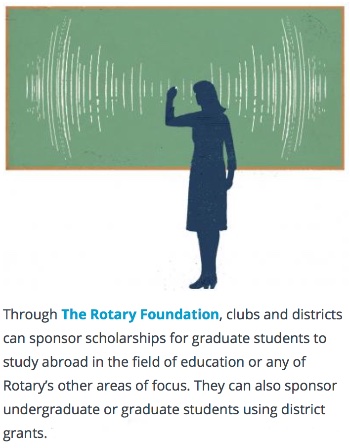.jpg)
Break the sound barrier (as a teacher for the deaf)
Jean Irwin Hatfield, Rotary Club of Folsom, CA (Published in The Rotarian - January 2018)
When I decided to become a teacher for the deaf, I enrolled in a program at Fresno State. We started with 80 candidates, but by graduation we were down to 13. That’s how intense the program was.
People don’t realize the linguistic challenges of deaf students, especially the trouble they have learning to read. Why is that? Because reading is a sound/symbol system. You don’t read with your eyes but with your ears. This is why blind students, for instance, read at the same level as their sighted peers, while deaf students might graduate from high school reading at a fourth-grade level.
When I started out, 38 years ago, teachers dealt with this problem using workarounds, trying to figure out how to get information to deaf students in ways that didn’t involve reading. Then I heard about a professor in England, David Wood, who was doing groundbreaking work with the deaf.
 He was studying artificial intelligence, and he fed a computer all the rules of English and programmed it to generate language. But the language that came out was very strange. He passed it around to his colleagues and someone said, ‘That’s deaf language!’ And he had this epiphany: A computer is deaf! A computer has no ear for language. So he realized that he would have to study how deaf people process language if he wanted to understand how computers process language. That’s how he came to form the Learning Sciences Research Institute at the University of Nottingham.
He was studying artificial intelligence, and he fed a computer all the rules of English and programmed it to generate language. But the language that came out was very strange. He passed it around to his colleagues and someone said, ‘That’s deaf language!’ And he had this epiphany: A computer is deaf! A computer has no ear for language. So he realized that he would have to study how deaf people process language if he wanted to understand how computers process language. That’s how he came to form the Learning Sciences Research Institute at the University of Nottingham.
I was at a party talking about all this when a Rotarian overheard me and said, “You know, we have a program that sends teachers overseas to continue their education. ” I received an Ambassadorial Scholarship worth $26,000, more than I was earning at the time. The problem was Professor Wood. He told me, “We don’t train teachers of the deaf. ” So the Rotarians sent another Rotarian who worked in the university’s engineering department to talk to him, and he finally allowed me to come over and help with the research.
The technique that Professor Wood focused on, story retelling, had been in the educational toolbox for a long time. It’s based on a crucial insight, one that educators tend to overlook, which is that students develop language intrinsically. How we talk to ourselves in our own heads is really more important than the communication between two people.
We didn’t work with grammar books. Instead, we would have students read the same story over and over, then have them retell that story. The kids were confused at first, because they were so used to being with speech therapists and specialists who talked for them. But Professor Wood was very strict. You said nothing. You let the uncomfortable silence go. Eventually the kids would realize you were going to let them keep talking, and you could see the wheels turning. They would start to correct themselves. It was amazing to watch them have that moment.
Now, education is never quick. It’s not like microwaving something. You have to be patient and consistent. But with my students, I started seeing things in writing and reading that I had never seen from deaf children before. And once I saw that, there was no going back. I realized that I could choose particular stories that would help with whatever clause structures that student was struggling to master. I also figured out that stories with a lot of repeated dialogue were crucial, because when my students repeated the dialogue, you hear the music come into their voices and out would come these perfect sentences.
After using this method for several years, my graduating students went from reading at a fourth-grade level to a 10th-grade level, and some of them were exceeding that. Some graduated from college.
I just went back into teaching after being retired for eight years. Once again the kids have very low reading levels, so I’m starting all over again.
I speak at reading conferences, and I always get letters from teachers who tell me, “Oh, my gosh. What a game changer this method has been!” So when I tell Rotarians how much the scholarship has meant, I’m not just blowing air up their skirts. It’s amazing how much the lives of these kids have been changed just by giving one year of education to one teacher of the deaf.
As told to Steve Almond